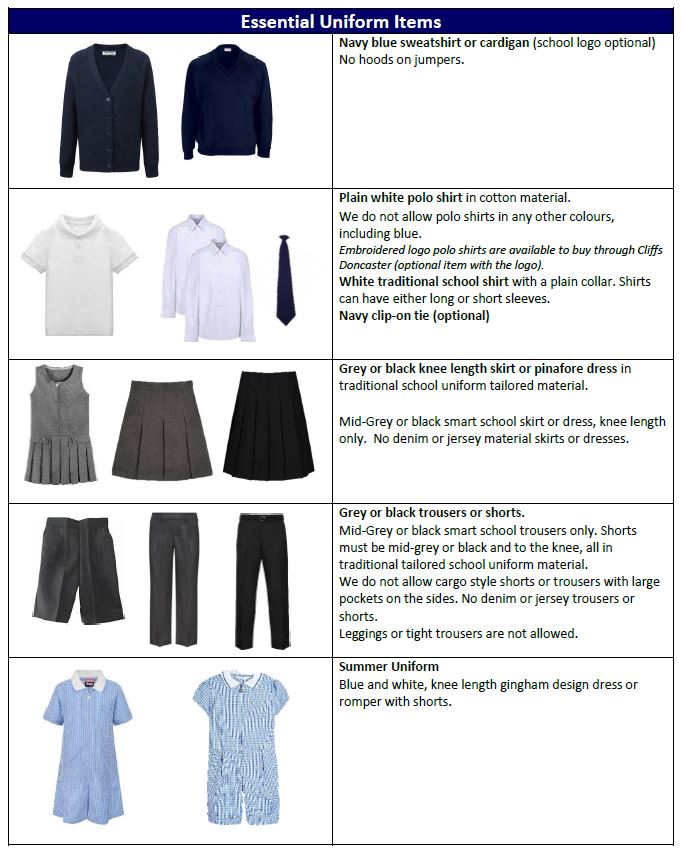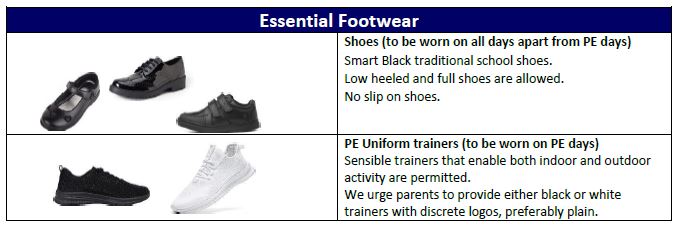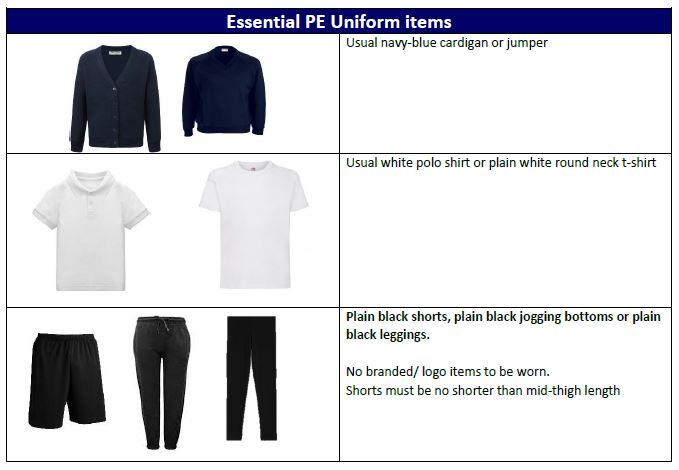- Parents
- Attendance
- Term Dates
- School Opening Hours
- Holidays in term time
- Emergency School Closures
- How we manage behaviour
- Anti-Bullying
- School Uniform
- School Meals
- Packed Lunches
- Fruit and Milk
- Home Learning
- Remote Education
- Letters
- Support for parents
- SEND & Looked After Children (LAC)
- Early Help
- Thrive
- Children's University
- Online Safety
School Uniform
We allow pupils to wear a range of options linked to our school colours and traditional uniform:
- navy blue sweatshirt or cardigan (school logo optional)
- white polo shirt (school logo optional) or white blouse/shirt with navy tie (optional)
- navy/grey/black skirt or trousers
- grey/black school shorts
- grey pinafore or blue gingham dress
- black sensible school shoes/school trainers (no high heels, slip-ons or sandals, preferably Velcro-fastening for younger pupils)
- navy, white or black hair accessories.
- cold weather: warm coat, hat and gloves
- warmer weather: waterproof jacket and navy, black or white sunhat without logos.
We do not require pupils to wear any items with logos, although these are an option for families who would like this.
We encourage families to adapt uniform to take into account their cultural backgrounds or religion.
The school also specific rules regarding hair styles and the wearing of make-up, nail varnish and nail extensions. This is because we want pupils to focus on their learning. We do not want to encourage an environment where children are competing in terms of their appearance or how “fashionable” they look.


PE Kit
To minimise the financial burden of a separate PE kit, pupils wear their usual t-shirt and, in colder weather, their sweatshirt. Pupils in Years 1 to 6 should arrive at school dressed in their PE bottoms and will wear these all day.
Our school PE kit includes:
- usual navy blue sweatshirt (for outdoor PE, school logo optional)
- usual white polo shirt (school logo optional)
- navy blue/black sports shorts (no logos)
- navy blue/black leggings or tracksuit bottoms (for outdoor PE, no logos)
- plain trainers
Swimming kit for pupils in Years 4 and 5:
- navy/dark coloured swimsuit or trunks
- towel


Uniform suppliers
Sweatshirts and polo shirts with the school logo can be purchased from:
- Cliff’s Menswear, Printing Office Street, Doncaster
- www.schoolwearsolutions.com
Tesco, Asda and other supermarkets have a range of lower cost uniform options without logos.
Make-Up
Make-up and false eyelashes are not permitted. It is not deemed appropriate or necessary for children aged 3-11 to wear make-up in the school environment. If pupils bring items of make-up to school, staff will retain these until the end of the school day. Parents/carers may collect these from the school office at the end of the day.
Nail Varnish and Nail Extensions
Nail varnish and nail extensions are not permitted. It is not deemed appropriate or necessary for children aged 3-11 to wear nail varnish or nail extensions in the school environment. In addition, nail varnish or extensions can pose risks for children at certain times of the school day. Long false nails or extensions can be trapped or ripped moving around school, causing considerable pain and upset. They can cause harm to others in practical activities such as at break times or in PE games. Pupils wearing nail varnish/extensions involved in cooking activities in design and technology lessons can contaminate food with chippings of nail varnish or parts of nail extensions. If a pupil comes to school with nail extensions they will be isolated during break and lunch time to minimise any risk of injury to themselves or to others.
Hairstyles
All hairstyles should be appropriate for school. It is not deemed appropriate or necessary for children aged 3-11 in a school environment to have extreme hairstyles, hair dye/colouring, or lines/patterns shaved into hair. We also require that any hair which is shoulder length or longer be tied back at all times and that any hair accessories be reasonably sized, and navy blue, white or black. If a pupil comes to school with untied long hair they will be isolated during break and lunch time to minimise any risk of injury to themselves or to others.

Jewellery
With the exception of plain stud earrings (no more than one per ear), jewellery should not usually be worn in school. We will adapt our policy on religious grounds, but ask that we are made aware of any requests in advance of jewellery being worn so that we can communicate variations to staff. All jewellery should usually be removed for PE lessons. Where earrings cannot be removed, parents should provide plasters to cover them.
What will happen if my child does not conform to school expectations?
We believe that learning how to conform to expectations is important in life: it helps pupils prepare for secondary school, for work, and for important or formal social occasions.
School Uniform Policy
Further information can be found in our Uniform Policy within the policies section of our website.